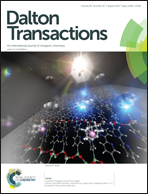Four super water-stable lanthanide–organic frameworks with active uncoordinated carboxylic and pyridyl groups for selective luminescence sensing of Fe3+†
Abstract
Four super water-stable isostructural lanthanide–organic frameworks, [Ln(HL)(H2O)2]n·2H2O (1-Ln) (Ln = Eu, Tb, Nd and Sm), have been successfully synthesized under hydrothermal conditions with 3,5-di(2,4-dicarboxylphenyl)pyridine (H4L) and Ln(NO3)3·6H2O. 1-Ln shows a novel 2D layered structure with uncoordinated carboxylic and pyridyl groups pointing to the interior of interlayer channels. The luminescent properties of 1-Eu in the solid state and one steeped in aqueous solution have been measured, which show excellent luminescence and good luminescent stability in water. Next 1-Eu was chosen as a probe for sensing different metal ions. Consequently, 1-Eu exhibits a highly selective response to Fe3+ through the luminescence quenching effect in aqueous solutions. The probable mechanisms of the quenching effects have been investigated in detail.


 Please wait while we load your content...
Please wait while we load your content...